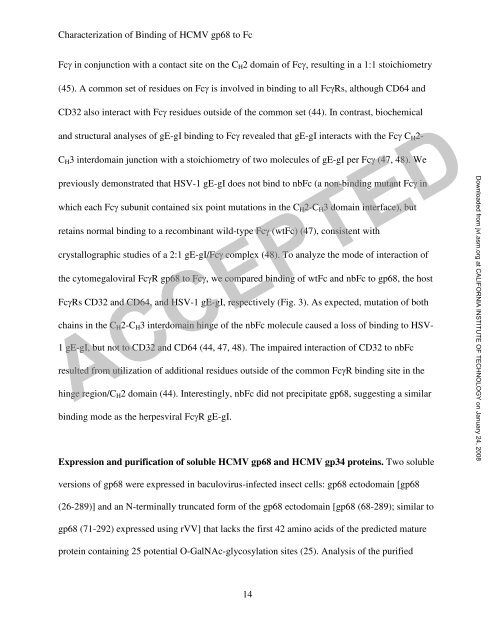The Human Cytomegalovirus Fc Receptor gp68 Binds the Fc CH2 ...
The Human Cytomegalovirus Fc Receptor gp68 Binds the Fc CH2 ...
The Human Cytomegalovirus Fc Receptor gp68 Binds the Fc CH2 ...
You also want an ePaper? Increase the reach of your titles
YUMPU automatically turns print PDFs into web optimized ePapers that Google loves.
Characterization of Binding of HCMV <strong>gp68</strong> to <strong>Fc</strong><br />
<strong>Fc</strong>γ in conjunction with a contact site on <strong>the</strong> C H 2 domain of <strong>Fc</strong>γ, resulting in a 1:1 stoichiometry<br />
(45). A common set of residues on <strong>Fc</strong>γ is involved in binding to all <strong>Fc</strong>γRs, although CD64 and<br />
CD32 also interact with <strong>Fc</strong>γ residues outside of <strong>the</strong> common set (44). In contrast, biochemical<br />
and structural analyses of gE-gI binding to <strong>Fc</strong>γ revealed that gE-gI interacts with <strong>the</strong> <strong>Fc</strong>γ C H 2-<br />
C H 3 interdomain junction with a stoichiometry of two molecules of gE-gI per <strong>Fc</strong>γ (47, 48). We<br />
previously demonstrated that HSV-1 gE-gI does not bind to nb<strong>Fc</strong> (a non-binding mutant <strong>Fc</strong>γ in<br />
which each <strong>Fc</strong>γ subunit contained six point mutations in <strong>the</strong> C H 2-C H 3 domain interface), but<br />
retains normal binding to a recombinant wild-type <strong>Fc</strong>γ (wt<strong>Fc</strong>) (47), consistent with<br />
crystallographic studies of a 2:1 gE-gI/<strong>Fc</strong>γ complex (48). To analyze <strong>the</strong> mode of interaction of<br />
<strong>the</strong> cytomegaloviral <strong>Fc</strong>γR <strong>gp68</strong> to <strong>Fc</strong>γ, we compared binding of wt<strong>Fc</strong> and nb<strong>Fc</strong> to <strong>gp68</strong>, <strong>the</strong> host<br />
<strong>Fc</strong>γRs CD32 and CD64, and HSV-1 gE-gI, respectively (Fig. 3). As expected, mutation of both<br />
chains in <strong>the</strong> C H 2-C H 3 interdomain hinge of <strong>the</strong> nb<strong>Fc</strong> molecule caused a loss of binding to HSV-<br />
ACCEPTED<br />
1 gE-gI, but not to CD32 and CD64 (44, 47, 48). <strong>The</strong> impaired interaction of CD32 to nb<strong>Fc</strong><br />
resulted from utilization of additional residues outside of <strong>the</strong> common <strong>Fc</strong>γR binding site in <strong>the</strong><br />
hinge region/C H 2 domain (44). Interestingly, nb<strong>Fc</strong> did not precipitate <strong>gp68</strong>, suggesting a similar<br />
binding mode as <strong>the</strong> herpesviral <strong>Fc</strong>γR gE-gI.<br />
Expression and purification of soluble HCMV <strong>gp68</strong> and HCMV gp34 proteins. Two soluble<br />
Downloaded from jvi.asm.org at CALIFORNIA INSTITUTE OF TECHNOLOGY on January 24, 2008<br />
versions of <strong>gp68</strong> were expressed in baculovirus-infected insect cells: <strong>gp68</strong> ectodomain [<strong>gp68</strong><br />
(26-289)] and an N-terminally truncated form of <strong>the</strong> <strong>gp68</strong> ectodomain [<strong>gp68</strong> (68-289); similar to<br />
<strong>gp68</strong> (71-292) expressed using rVV] that lacks <strong>the</strong> first 42 amino acids of <strong>the</strong> predicted mature<br />
protein containing 25 potential O-GalNAc-glycosylation sites (25). Analysis of <strong>the</strong> purified<br />
14
















